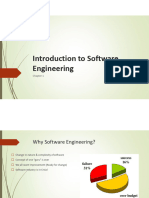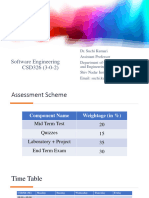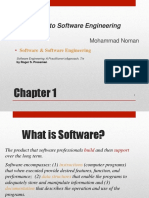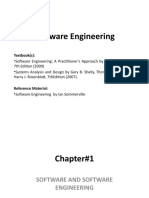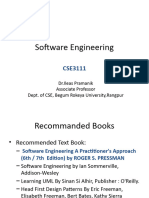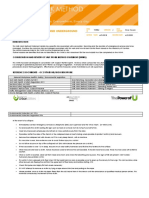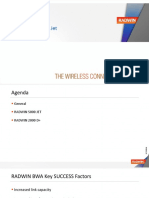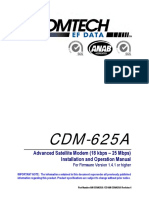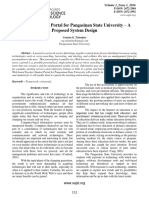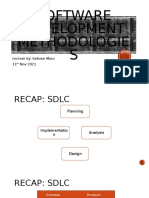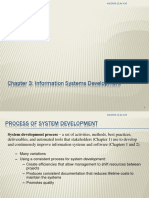PAN African eNetwork Project
Post Graduate Diploma (IT)
Software Engineering
Semester - I
Mr. O.P.Sangwan
Copyright Amity University
1
�Faculty Profile
MSc (Computer Science)
CCNA (Cisco certified Network Associate)
CCNA (Cisco certified )
Ph D (CSE) (Thesis Submitted)
Publications
International/ National Journal = 8 (including ACM, ISJKE)
International/ National Conference = 9 (including Springer)
Conference/ Workshop Attended
Bangkok
Vietnam
Copyright Amity University
�Patents filed provisionally
ANN model
Area of specialization
Software Engineering
Artificial Intelligence
Experience
5 + teaching
1 research
Member
Cisco (Academic Council, USA)
Cisco (Learning Institute, USA)
Copyright Amity University
�Why We Need Software
Engineering?
Change in nature & complexity of software
Concept of one guru is over
We all want improvement
Copyright Amity University
�Why Software Engineering?
Software development is hard !
Important to distinguish easy systems (one
developer, one user, experimental use only) from hard
systems (multiple developers, multiple users, products)
Experience with easy systems is misleading
One person techniques do not scale up
Analogy with bridge building:
Over a stream = easy, one person job
Over River Severn ?
(the techniques
Copyright Amity University
do not scale)
�Software Crisis!
�Software Crises
As per the IBM report, 31%of the
project get cancelled before they are
completed, 53% over-run their cost
estimates by an average of 189% and
for every 100 projects, there are 94
restarts.
Copyright Amity University
�Factors Contributing Software Crises
Larger problems,
Lack of adequate training in software
engineering
Increasing skill shortage,
Low productivity improvements
Copyright Amity University
�Some Software failures
Ariane 5
It took the European Space Agency 10 years
and $7 billion to produce Ariane 5, a giant
rocket capable of hurling a pair of three-ton
satellites into orbit with each launch and
intended to give Europe overwhelming
supremacy in the commercial space business.
The rocket was destroyed after 39 seconds of
its launch, at an altitude of two and a half
miles along with its payload of four expensive
and uninsured scientific satellites.
�Some Software failures
When the guidance systems own
computer tried to convert one piece
of data the sideways velocity of the
rocket from a 64 bit format to a 16
bit format; the number was too big,
and an overflow error resulted after
36.7 seconds. When the guidance
system shutdown, it passed control
to an identical, redundant unit, which
was there to provide backup in case
of just such a failure. Unfortunately,
the second unit, which had failed in
the
identical
manner
a
few
milliseconds before.
10
�Some Software
failures
Y2K problem:
It was simply the ignorance about the
adequacy or otherwise of using only
last two digits of the year.
The 4-digit date format, like 1964, was
shortened to 2-digit format, like 64.
11
�Some Software failures
The Patriot Missile
o First time used in Gulf war
o Used as a defense from Iraqi Scud
missiles
o Failed several times including one that
killed 28 US soldiers in Dhahran, Saudi
Arabia
Reasons:
A small timing error in the systems clock
accumulated to the point that after 14
hours, the tracking system was no longer
accurate. In the Dhahran attack, the system
had been operating for more than 100
hours.
12
�Some Software failures
The Space Shuttle
Part of an abort scenario
for the Shuttle requires
fuel dumps to lighten the
spacecraft. It was during
the second of these
dumps that a (software)
crash occurred.
...the fuel management
module,
which
had
performed one dump
and successfully exited,
restarted when recalled
for the second fuel
13
�Some Software failures
Windows XP
o Microsoft released Windows XP on October
25, 2001.
o On the same day company posted 18 MB of
compatibility patches on the website for
bug fixes, compatibility updates, and
enhancements.
o Two patches fixed important security holes.
14
�What is software?
It is defined as Computer programs
and associated documentation
15
Copyright Amity University
�What is software?
Programs
Documenta
tion
Operating
Procedures
Software=Program+Documentation+Operating Procedures
Components of software
16
�What are the attributes of good software?
The software should deliver the required functionality
and performance to the user and should be
maintainable, dependable and usable
Maintainability
Software must evolve to meet changing needs
Dependability
Software must be trustworthy
Efficiency
Software should not make wasteful use of system resources
Usability
Software must be usable by the users for which it was
designed
�Documentation consists of different types of
Formal
manuals are
Specification
Analysis
/
Specificatio
n
Design
Documentat
ion
Manuals
Implementati
on
Testing
ContextDiagram
Data Flow
Diagrams
Flow Charts
EntityRelationship
Diagram
Source Code
Listings
CrossReference
Listing
Test Data
Test Results
List of documentation manuals
18
�Documentation consists of different types
System
of manuals are
Overview
User
Manuals
Beginners
Guide Tutorial
Reference
Guide
Operatin
g
Procedu
res
Operation
al
Manuals
Installation
Guide
System
Administration
Guide
List of operating procedure manuals.
19
�What is a software
process?
A set of activities whose goal is the
development or evolution of software
Generic activities in all software
processes are:
Specification - what the system should
do and its development constraints
Development - production of the
software system
Validation - checking that the software
is what the customer wants
Evolution - changing the software in
response to changing demands
�What is a software process model?
A simplified representation of a software
process,
presented from a specific perspective
Examples of process perspectives:
Workflow perspective represents inputs, outputs and
dependencies
Data-flow perspective represents data transformation
activities
Role/action perspective represents the roles/activities of the
people involved in software
process
Generic process models
Waterfall
Evolutionary development
Formal transformation
Integration from reusable components
�Software Product
Software products may be developed for a
particular customer or may be developed for
a general market
Software products may be
Generic - developed to be sold to a range of different customers
Bespoke (custom) - developed for a single customer according to
their specification
22
�What is software engineering?
Software engineering is an engineering discipline which is
concerned with all aspects of software production
Software engineers should
adopt a systematic and organised approach to their
work
use appropriate tools and techniques depending on
the problem to be solved,
the development constraints and
use the resources available
23
Copyright Amity University
�What is software
engineering?
At the first conference on software engineering in 1968, Fritz Bauer
defined software engineering as The establishment and use of sound
engineering principles in order to obtain economically developed
software that is reliable and works efficiently on real machines.
Stephen Schach defined the same as A discipline whose aim is the
production of quality software, software that is delivered on time, within
budget, and that satisfies its requirements.
Both the definitions are popular and acceptable to majority. However,
due to increase in cost of maintaining software, objective is now shifting
to produce quality software that is maintainable, delivered on time,
within budget, and also satisfies its requirements.
24
�Software Process
The software process is the way in which we
produce software.
Why is it difficult to improve software
process ?
Not enough time
Lack of knowledge
25
�Software Process
Wrong motivations
Insufficient commitment
Initial
state
state
Process
improvement
begins
Improved future
state
Productivity
Do not quit here!
Learning curve
Time
26
�Software Characteristics:
Software does not wear out.
Failure Intensity
Burn-in
phase
Useful life
phase
Wear out
phase
Time
27
�Software Characteristics:
Software is not manufactured
Reusability of components
Software is flexible
28
�Software Characteristics:
Comparison of constructing a bridge vis--vis writing a program.
Sr.
No
1.
2.
3.
4.
5.
6.
7.
Constructing a bridge
The problem is well understood
There are many existing
bridges
The requirement for a bridge
typically do not change much
during
construction
The
strength
and stability of a
bridge can be calculated with
reasonable
precision
When a bridge
collapses, there is
a detailed investigation and
report
Engineers have been constructing
bridges for thousands of years
Materials (wood, stone,iron, steel)
and techniques (making joints in
wood, carving stone, casting iron)
change slowly.
Writing a program
Only some parts of the problem are
understood, others are not
Every program is different and
designed for special applications.
Requirements
typically
change
during all phases of development.
Not possible to calculate correctness
of a program with existing methods.
When a program fails, the reasons
are often unavailable or even
deliberately
Developers concealed.
have been writing
programs for 50 years or so.
Hardware and software changes
rapidly.
29
�Software Applications
System
Softwa
re
Real
Time
Softwa
re
Engineeri
Embedd
ng and
ed
Scientific
Software
Software
Web
Busine
based
ss
Software
Softwa
Artificial
re
Person
Intelligen
al
ce
Software Comput
er
Softwar
e
30
�The Changing Nature of
Software
Trend has emerged
to provide source code
to the customer and organizations.
Software where source codes are available
are known as open source software.
Examples
Open source software: LINUX, MySQL, PHP, Open office, Apache
webserver etc.
31
�Software Myths (Management
Perspectives
Management may
be confident about) good
standards and clear procedures of the company.
But the taste of any food item
is in the eating;
not in the Recipe !
32
Copyright Amity University
�Software Myths (Management
Company has
latest computers
Perspectives
) and stateof-the-art software tools, so we shouldnt
worry about the quality of the product.
The infrastructure is
only one of the several factors
that determine the quality
of the product!
33
Copyright Amity University
�Software Myths (Management
Perspectives
) those with
Addition of more
software specialists,
higher skills and longer experience may bring the
schedule back on the track!
Unfortunately,
that may further delay the schedule!
34
Copyright Amity University
�Software Myths
(Management Perspectives)
Software is easy to change
The reality is totally different.
35
�Software Myths
(Management Perspectives)
Computers
provide
greater
reliability than the devices they
replace
This is not always true.
36
�Software Myths (Customer
A general statement
of objectives is )
sufficient to get
Perspectives
started with the development of software. Missing/vague
requirements can easily be incorporated/detailed out as
they get concretized.
If we do so, we are heading
towards a disaster.
37
Copyright Amity University
�Software Myths (Customer
Perspectives
Software with
more features ) is
better software
Software can work right the first time
Both are only myths!
38
�Software Myths (Developer
Perspectives)
Once the software is demonstrated, the job is
done.
Usually, the problems just begin!
39
Copyright Amity University
�Software Myths (Developer
Software quality
can not be assessed
Perspectives
) before
testing.
owever, quality assessment techniques
should be used through out the
software development life cycle.
40
Copyright Amity University
�Software Myths (Developer
The only Perspectives
deliverable for )a software
development project is the tested code.
sted code is only one of the deliverable!
41
Copyright Amity University
�Software Myths (Developer
Perspectives
)
Aim is to develop
working programs
Those days are over. Now objective is to
develop good quality maintainable
programs!
42
�Some Terminologies
Deliverables and Milestones
Different deliverables are generated during software development. The
examples are source code, user manuals, operating procedure manuals
etc.
The milestones are the events that are used to ascertain the status of the
project. Finalization of specification is a milestone. Completion of design
documentation is another milestone. The milestones are essential for
project planning and management.
43
�Some Terminologies
Product and Process
Product: What is delivered to the customer, is called a product. It may
include source code, specification document, manuals, documentation
etc. Basically, it is nothing but a set of deliverables only.
Process: Process is the way in which we produce software. It is the
collection of activities that leads to (a part of) a product. An efficient
process is required to produce good quality products.
If the process is weak, the end product will undoubtedly suffer, but an
obsessive over reliance on process is also dangerous.
44
�Some Terminologies
Measures, Metrics and Measurement
A measure provides a quantitative indication of the extent, dimension,
size, capacity, efficiency, productivity or reliability of some attributes of
a product or process.
Measurement is the act of evaluating a measure.
A metric is a quantitative measure of the degree to which a system,
component or process possesses a given attribute.
45
�Some Terminologies
Software Process and Product Metrics
Process metrics quantify the attributes of software development process
and environment;
whereas product metrics are measures for the software product.
Examples
Process metrics: Productivity, Quality, Efficiency etc.
Product metrics: Size, Reliability, Complexity etc.
46
�Some Terminologies
Productivity and Effort
Productivity is defined as the rate of output, or production per unit of
effort, i.e. the output achieved with regard to the time taken but
irrespective of the cost incurred.
Hence most appropriate unit of effort is Person Months (PMs), meaning
thereby number of persons involved for specified months. So, productivity
may be measured as LOC/PM (lines of code produced/person month)
47
�Some Terminologies
Module and Software Components
There are many definitions of the term module. They range from a
module is a FORTRAN subroutine to a module is an Ada Package, to
Procedures and functions of PASCAL and C, to C++ Java classes to
Java packages to a module is a work assignment for an individual
developer. All these definition are correct. The term subprogram is also
used sometimes in place of module.
48
�Some Terminologies
An independently deliverable piece of functionality providing access to
its services through interfaces.
A component represents a modular, deployable, and replaceable part
of a system that encapsulates implementation and exposes a set of
interfaces.
49
�Some Terminologies
Generic and Customized Software Products
Generic products are developed for anonymous customers. The target is
generally the entire world and many copies are expected to be sold.
Infrastructure software like operating system, compilers, analyzers, word
processors, CASE tools etc. are covered in this category.
The customized products are developed for particular customers. The
specific product is designed and developed as per customer
requirements. Most of the development projects (say about 80%)come
under this category.
50
�Role of Management in Software
Development Factors
People
Project
Product
Process
51
�Role of Management in Software
People
Development
1
Project
Depende
ncy
Product
Order
3
Process
52
�Software Development Life Cycle
Requirement Analysis &
Specification
Design
Coding
Testing
Maintenance & Operations
Copyright Amity University
�Software Life Cycle Model
Waterfall Model
Prototype Model
Iterative Enhancement Model
Evolutionary Development Model
Spiral Model
Rapid Application Development (RAD) Model
Copyright Amity University
�Waterfall Model
Linear Sequential Model
Classical Life Cycle Model
Requirement
Design
Implementation
andunittesting
Integr ationand
systemtesting
Operation &
Maintenance
Copyright Amity University
�Problems with the Waterfall Model
It is difficult to define all requirements at the beginning of
a project
This model is not suitable for accommodating any
change
A working version of the system is not seen until late in
the projects life
It does not scale up well to large projects
Real projects are rarely sequential
Copyright Amity University
�Prototype Model
It is also known as throw away model.
It is developed as per the current available
requirement.
The code for the prototype model is
thrown away; however the experience
gathered from developing the prototype
helps in developing the actual system.
Copyright Amity University
�Prototype Model
Linear model
Rapid
58
Copyright Amity University
�Iterative Enhancement Model
Requirements
specification
Architectural
design
Detailed
design
Implementation
and unit testing
Integration
and testing
Operation and
Maintenance
59
�Evolutionary Process Models
Evolutionary
process
model
resembles
iterative
enhancement model. The same phases as defined for the
waterfall model occur here in a cyclical fashion. This model
differs from iterative enhancement model in the sense that
this does not require a useable product at the end of each
cycle. In evolutionary development, requirements are
implemented by category rather than by priority.
This model is useful for projects using new technology that
is not well understood. This is also used for complex projects
where all functionality must be delivered at one time, but the
requirements are unstable or not well understood at the
beginning.
60
�Evolutionary Development Model
Concurr ent
activities
Outline
description
Copyright Amity University
Specification
Initial
version
Development
Intermediate
versions
Validation
Final
version
�Spiral Model
Phases of Spiral Model
Planning: Determination of objectives,
alternatives and constraints.
Risk Analysis: Analyze alternatives and
attempts to indentify and resolve the risks
involved
Development: Product development and
testing product.
Assessment: Customer evaluation
Copyright Amity University
�Spiral Model
63
�Rapid Application Development (RAD) Model
Build a rapid prototype
Give it to user for evaluation & obtain feedback
Prototype is refined
With active participation of users
Requirement
s
Planning
User
Description
Construction
Cut over
64
�Rapid Application Development (RAD) Model
Not an appropriate model in the absence of user
participation.
Reusable components are required to reduce
development time.
Highly specialized & skilled developers are required
and such developers are not easily available.
65
�Multiple Choice Questions
Note: Select most appropriate answer of the following questions:
1.1 Software is
(a) Superset of programs
(b) subset of
programs
(c) Set of programs
(d) none of the above
1.2 Which is NOT the part of operating procedure manuals?
(a) User manuals
(b) Operational manuals
(c) Documentation manuals
(d) Installation
manuals
1.3 Which is NOT a software characteristic?
(a) Software does not wear out
(b) Software is
flexible
(c) Software is not manufactured
(d) Software is
1.4 always
Productcorrect
is
(a) Deliverables
(b) User expectations
(c) Organization's effort in development
(d) none of
the above
1.5 To produce a good quality product, process should be
(a) Complex
(b) Efficient
(c) Rigorous
(d) none of the above
66
�Multiple Choice Questions
Note: Select most appropriate answer of the following questions:
1.6 Which is not a product metric?
(a) Size
(c) Productivity
(b) Reliability
(d) Functionality
1.7 Which is NOT a process metric?
(a) Productivity
(b) Functionality
(c) Quality
(d) Efficiency
1.8 Effort is measured in terms of:
(a) Person-months
(c) Persons
(b) Rupees
(d) Months
1.9 UML stands for
(a) Uniform modeling language (b) Unified modeling
language
(c) Unit modeling language
(d) Universal
1.10modeling
An independently
language deliverable piece of functionality providing
access to
its services through interface is called
(a)
Software
measurement
(b)
Software
67
composition
�Thank You
Please forward your query
To: sangwan_op@aiit.amity.edu
CC: manoj.amity@panafnet.com
68









